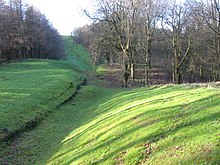
The architecture of Scotland in the Roman era includes all building within the modern borders of Scotland, from the arrival of the Romans in northern Britain in the first century BCE, until their departure in the fifth century CE. Ptolemy indicated that there were 19 "towns" in Caledonia, north of the Roman province of Britannia, but no clear evidence of urban settlements has been found and these were probably hillforts. There is evidence of over 1,000 such forts, most south of the Clyde-Forth line, but the majority seem to have been abandoned in the Roman period. There is also evidence of distinctive stone wheelhouses and small underground souterrains.
From about 71 CE the Romans began military expeditions into what is now Scotland, building forts, like that at Trimontium, and probably pushing north as far as the River Tay where they created more fortifications, like those at Inchtuthil. These were soon abandoned, and the Romans settled for the occupation of the Southern Uplands by the end of the first century, south of a line drawn between the Tyne and Solway Firth. This resulted in more fortifications and the building of Hadrian's Wall across what is now northern England. Around 141 CE they moved up to construct a new limes, a sward-covered wall made of turf known as the Antonine Wall, the largest Roman structure in modern Scotland. They soon retreated to Hadrian's Wall, with occasional expeditions that involved the building and reoccupation of forts, until the collapse of Roman power in the early fifth century.